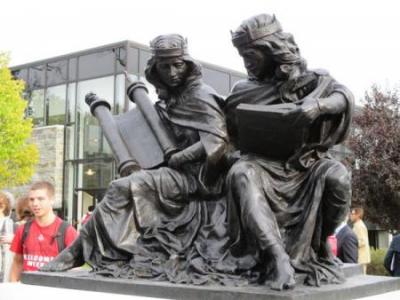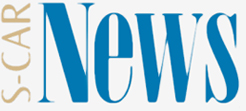Pope Francis in America: A Biased Perspective
Pope Francis in America: A Biased Perspective
 Washington, DC, Manhattan, and Philadelphia were paralyzed yet filled with excitement. John Paul II had drawn big enthusiastic crowds on his visits, but there was a distinct quality of multi-faith and even atheistic excitement for Francis.
Washington, DC, Manhattan, and Philadelphia were paralyzed yet filled with excitement. John Paul II had drawn big enthusiastic crowds on his visits, but there was a distinct quality of multi-faith and even atheistic excitement for Francis.
He had forsworn the limousine after his election as pope, and taken the minibus with his fellow cardinals back to their rooms. He chose to live in a small apartment and not the grandiose traditional apartment of the pontiff. Francis visited young prisoners in Rome and washed their feet on Holy Thursday before Good Friday in 2013. The twelve youth included two women and two Muslims. The next year, he went to a home for the disabled and washed the feet of Christians, non-Christians, and non-believers. Traditionally, popes would wash the feet of priests.
That’s what he does. There is a strong tradition among certain Hebrew prophets, known intimately to Jesus of Nazareth, and revealed to Prophet Muhammad, which enjoins believers to care for the poor and the sick, the widows and orphans — those most needy and often treated as the least among us.
Francis was all Jesus all the time. But not a finger-wagging critic or fire and brimstone preacher. Since we are all sinners — I’ll risk a blatant generalization here — Francis drew almost everyone in. (There was one Arizona Republican congressman, a Catholic even, who boycotted the joint meeting of Congress because he said Francis was too liberal and believed in the dangers of climate change. He sent out a fund-raising letter extolling his courage.)
In New York, the Washington Post reported that after Francis addressed the UN General Assembly and prayed at the World Trade Center site, he drove up to Central Park. At the moment his car came into view, a rainbow appeared above Central Park West and 63rd St. “And then a wisp of a cloud perpendicular to the rainbow created the shape of a cross…. People wept. These people were already believers, but this, as people around here say, was ridiculous. Naturally, they credited the pope.”
There is no way for me to capture the impact of the pope’s exhaustive and exhausting program in our country. And so I will focus on those efforts most moving to me and most relevant to our concerns for conflict analysis and resolution. Time published a special edition called “Francis: The Pope’s Bold Message Comes to America,” by John l. Allen, Jr., Vatican specialist for the Boston Globe, that noted that Francis’ visit was his first and that “America is the mother ship of free-market global capitalism that Francis, history’s first pontiff from the developing world, routinely excoriates as ‘savage’ for fostering an ‘economy that kills,’ denouncing it as responsible for a ‘throwaway culture’ in which whole categories of human beings are regarded as disposable.” Allen also said that the U.S. had given Francis possibly his best-known antagonist, the very conservative Cardinal Raymond Burke formerly of La Crosse, Wisconsin, and St. Louis. At a summit of bishops from around the world in October, 2014, Burke suggested that Francis owed the church an apology for suggesting that its traditional ban on divorced and civilly remarried Catholics receiving the sacrament of communion could change. Burke had also insisted that Secretary of State John Kerry could not receive communion because he is pro-choice.
Francis is so soft-spoken, even in his native Spanish, that it’s hard to imagine him as tough. But the pope soon removed Cardinal Burke from his position as head of the Vatican Supreme Court and appointed him patron of the Sovereign Military Order of Malta, whatever that is. Burke had said the Church appeared rudderless under Francis. But he was the one who appeared to be up the Tiber without a paddle. And when Francis entered the House of Representatives for his joint address to Congress, in which the members had been strictly instructed not to touch him, the pope walked out of his prescribed path to single out John Kerry for a hand shake.
My bias is toward Francis as peacemaker. A highly respected Italian journalist, Massimo Franco, has written that Francis is potentially an even more crucial political actor than John Paul II, whose initiatives helped stimulate the collapse of communism in Central and Eastern Europe. “As the first pope from the developing world,” Franco wrote, “Francis is important for every issue facing the world today: poverty, the environment, immigration, and war.”
In June 2014, Francis invited the presidents of Palestine and Israel to come to the Vatican to pray for peace. This unplanned initiative started in May when Francis on his way to Bethlehem in the West Bank drove past what Israel calls a, “security fence,” and Palestinians call an, “apartheid wall.” He asked his driver to stop, and he went up to the wall and prayed silently for about five minutes. He then placed his hands on the wall, leaned forward so his forehead touched it, and made the sign of the cross. The Vatican spokesman, Father Frederico Lombardi, later said, “The pope thinks like a prophet. He imagines a day when the wall won’t be necessary to keep these two peoples apart."
Presidents Peres and Abbas went to Rome on June 8 to accept Francis’ invitation. As John Allen describes the scene, Peres and Abbas joined Francis who had also invited Patriarch Bartholomew I of Constantinople to the event. This fact also had major peacemaking implications because the Church of Rome and the Eastern Orthodox Church have still not formally healed the Great Schism of 1054 CE. The four men exchanged embraces and kisses before TV cameras, and then Francis led them into Vatican gardens that had no obvious Christian symbolism. Their service involved readings from scriptures and prayers from Judaism, Christianity, and Islam.
Francis said, “Peacemaking calls for courage, much more so than warfare. Only the tenacious say yes to encounter and no to conflict; yes, to negotiations and no to hostilities; yes to respect for agreements and no to acts of provocation.” The prayer meeting at the Vatican had been the result of careful planning by Pope Francis well before his trip to Israel and Palestine. At a Vatican meeting of forty Christians, Jews, and Muslims in 2014, Francis approached Omar Abboud, his countryman from Argentina and leader of the Islamic community in Buenos Aires. Francis told the stunned Abboud that for the first time in an official papal delegation to the Holy Land there will be a Jew and a Muslim. He said, “The Muslim is you.”
Francis had been developing ties to the Muslim community in Argentina as archbishop, and he had visited the Islamic Center in Buenos Aires three times. In November 2014, the Wall Street Journal reported the pope standing beside Istanbul Grand Mufti Rahmi Yaran in the legendary Blue Mosque facing Mecca and bowing his head in a long prayer. The National Report, an American conservative journal, reported with obvious discomfort that Francis had said, “the Koran, and the teachings contained therein, are just as valid as the Holy Bible.” Further, he said, “Jesus Christ, Jehovah, Allah. These are all names employed to describe an entity that is distinctly the same across the world.”
visited the Islamic Center in Buenos Aires three times. In November 2014, the Wall Street Journal reported the pope standing beside Istanbul Grand Mufti Rahmi Yaran in the legendary Blue Mosque facing Mecca and bowing his head in a long prayer. The National Report, an American conservative journal, reported with obvious discomfort that Francis had said, “the Koran, and the teachings contained therein, are just as valid as the Holy Bible.” Further, he said, “Jesus Christ, Jehovah, Allah. These are all names employed to describe an entity that is distinctly the same across the world.”
The Jew in the delegation to the Holy Land was to be Rabbi Abraham Skorka, head of the Latin American Rabbinical Seminary in Buenos Aires, and co-author of a book with Francis when he was Archbishop Jorge Bergoglio. I met Rabbi Skorka in Buenos Aires at the International Council of Christians and Jews (ICCJ) annual meeting last year, and in Rome this year at the ICCJ meeting, where I also had the chance to meet Pope Francis. My impression is that Rabbi Skorka may be Francis’ most trusted friend.
Toward the end of his Philadelphia visit, Francis went to St. Joseph’s University to bless a very special new bronze sculpture symbolizing Catholic unity with the Jews. Rabbi Skorka had given the dedication speech and arranged for Francis to stop by. (Skorka told the Forward that he had also been involved in arranging the Abrahamic summit at the Vatican.) The sculpture, by Joshua Koffman, titled “Synagoga and Ecclesia in Our Time,” depicts two women facing each other, one a Jew holding a Torah scroll and the other a Christian holding a Bible. It was meant to correct a medieval representation found on many European churches of Synagoga blindfolded by a snake and looking downcast like a loser to Eccelsia. Commenting on Francis’ role in attempting to heal the painful history of Jewish-Christian relations in Europe, the Forward’s Nathan Guttman wrote that many experts and Jewish communal officials, “believe that Francis has taken the relationship to a new level…a strong commitment to eradicating anti-Semitism from the Catholic Church with a unique personal approach and closeness to the Jewish community.”
To summarize Pope Francis’ impact in America, I yield to President Obama in his press conference of October 2, when asked his impression of the visit. Obama said, “I love Pope Francis. He’s a good man with a warm heart and a strong moral imagination. His impact here was great primarily for me on his emphasis on caring for the least among us. What more can we do to love, sacrifice, and help others. Pope Francis made me want to do better.”




